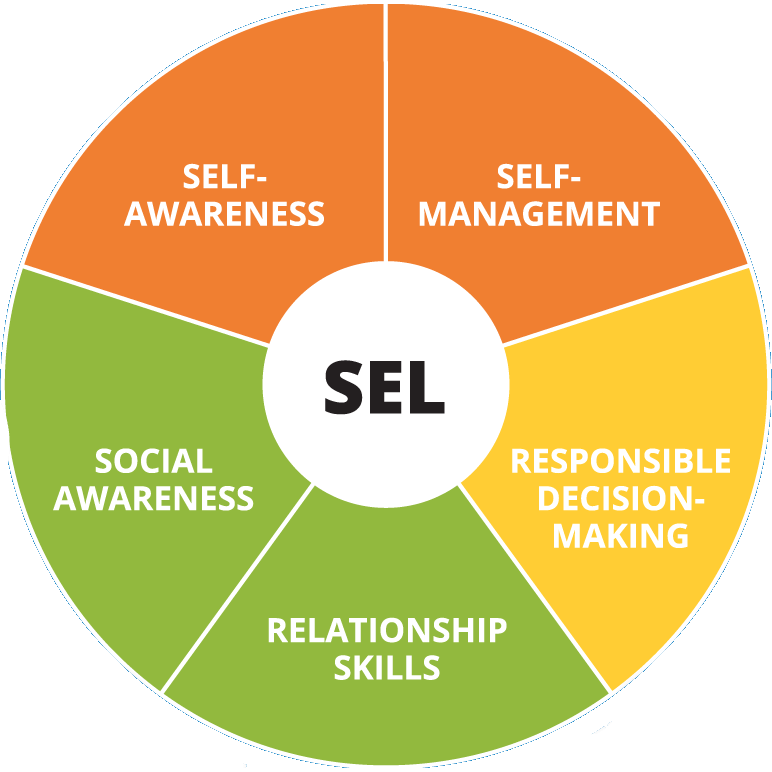SEL-35.RDM
 RDM Responsible Decision-Making RDM Responsible Decision-Making
Narrative
The ability to make constructive choices about the personal behavior and social interactions based on ethical standards, safety concerns, and social norms. The realistic evaluation of consequences of various actions, and a consideration of the wellbeing of oneself and others.
Indicators
- IP Identifying Problems Identify problems in a variety of situations.
- AS Analyzing Situations Apply strategies to appropriately solve problems.
- SP Solving Problems Utilize refusal skills.
- E&R Evaluating & Reflecting Compare and contrast the potential outcomes of engaging in safe and risky behaviors.
- ER Ethical Responsibility Demonstrate personal responsibility for decisions.
Proficiency Scale
I can ...
1 Beginning
... with help, demonstrates a partial understanding of some of the simpler details and processes (Score 2.0 content) and some of the more complex ideas and processes (Score 3.0 content).
2 Developing
... demonstrates no major errors or omissions regarding the simpler details and processes but exhibits major errors or omissions regarding the more complex ideas and processes (Score 3.0 content).Skills:- identify problems
- use strategies to solve problems
- identify refusal skills
- compare and contrast safe and unsafe behaviors
- identify consequences
3 Proficient
“The Standard.”... demonstrates no major errors or omissions regarding any of the information and processes that were end of instruction expectations.- identify and solve problems.
- make good choices.
- think about what could happen as a result from my choices.
- learn from my mistakes.
4 Advanced
... demonstrates in-depth inferences and applications regarding more complex material that go beyond end of instruction expectations.- also support others in making good choices.
Resources
Websites
- Title of website with a URL to open in a new window
|
|
SEL-35.ReS
 ReS Relationship Skills ReS Relationship Skills
Narrative
The ability to establish and maintain healthy and rewarding relationships with diverse individuals and groups. The ability to communicate clearly, listen well, cooperate with others, resist inappropriate social pressure, negotiate conflict constructively, and seek and offer help when needed.
Indicators
- C Communication Demonstrate non-verbal etiquette to foster better communication (e.g. looking and leaning, etc.).
- SE Social Engagement Analyze social situations at home, school and in the community (e.g. family meal time, free play, extracurricular activities, dances, diverse peer groups, etc.).
- RB Relationship Building Demonstrate appropriate strategies for providing and receiving feedback to promote group effectiveness.
- TW Teamwork Recognize and respond to social cues in a manner that builds and maintains healthy relationships.
- CR Conflict Resolution Differentiate between conflict and bullying.
Proficiency Scale
I can ...
1 Beginning
... with help, demonstrates a partial understanding of some of the simpler details and processes (Score 2.0 content) and some of the more complex ideas and processes (Score 3.0 content).
2 Developing
... demonstrates no major errors or omissions regarding the simpler details and processes but exhibits major errors or omissions regarding the more complex ideas and processes (Score 3.0 content).Skills:- understand non-verbal communication
- recognize non-verbal communication
- provide feedback
- define bullying
- identify conflict
- identify bullying
3 Proficient
“The Standard.”... demonstrates no major errors or omissions regarding any of the information and processes that were end of instruction expectations.- understand different social situations.
- give suggestions to others.
- listen and respond to others effectively.
- understand the difference between conflict and bullying.
4 Advanced
... demonstrates in-depth inferences and applications regarding more complex material that go beyond end of instruction expectations.- also help others make friends.
Resources
- non-verbal
- feedback
- bullying
Websites
- Title of website with a URL to open in a new window
|
|
SEL-35.SeA
 SeA Self-Awareness SeA Self-Awareness
Narrative
The ability to accurately recognize one's own emotions, thoughts, and values and how they influence behavior. Te ability to accurately assess one's strengths and limitations, with a well-grounded sense of confidence, optimism, and a "growth mindset."
Indicators
- IE Identifying Emotions Describe a variety of emotions, and understand how emotions are linked to behavior.
- RS Recognizing Strengths Describe interests to pursue and skills to develop.
- SCE Self-Confidences & Efficacy Develop a growth mindset for rigorous situations.
- ASP Accurate Self-Perception Describe an activity or task in which help is needed to be successful.
Proficiency Scale
I can ...
1 Beginning
... with help, demonstrates a partial understanding of some of the simpler details and processes (Score 2.0 content) and some of the more complex ideas and processes (Score 3.0 content).
2 Developing
... demonstrates no major errors or omissions regarding the simpler details and processes but exhibits major errors or omissions regarding the more complex ideas and processes (Score 3.0 content).Skills:- name emotions and feelings
- describe personal emotions and feelings
- identify causes of emotions and feelings
- describe how emotions affect behavior
- identify interests
- identify skills
- identify challenges
- ask for help when needed
- recognize when help is needed
3 Proficient
“The Standard.”... demonstrates no major errors or omissions regarding any of the information and processes that were end of instruction expectations.- understand how my emotions affect my behavior.
- name skills that I need to work on to do things that interest me.
- accept my challenges with confidence and positivity.
- name an activity that I need help with.
4 Advanced
... demonstrates in-depth inferences and applications regarding more complex material that go beyond end of instruction expectations.- also recognize how my behavior affects others.
Resources
Websites
- Title of website with a URL to open in a new window
|
|
SEL-35.SeM
 SeM Self-Management SeM Self-Management
Narrative
The ability to successfully regulate one's emotions, thoughts, and behaviors in different situations effectively managing stress, controlling impulses, and motivating oneself. The ability to set and work toward personal and academic goals.
Indicators
- IC Impulse Control Apply self-monitoring strategies to regulate emotions.
- SM Stress Management Identify personal stressors.
- SD Self-Discipline Display consistent behaviors to meet personal responsibilities.
- S-M Self-Management Identify internal and/or external motivating factors in a variety of situations.
- GS Goal Setting Apply a goal setting process to work toward goal achievement (e.g. SMART).
- OS Organizational Skills Identify strategies for planning, prioritizing and managing time.
Proficiency Scale
I can ...
1 Beginning
... with help, demonstrates a partial understanding of some of the simpler details and processes (Score 2.0 content) and some of the more complex ideas and processes (Score 3.0 content).
2 Developing
... demonstrates no major errors or omissions regarding the simpler details and processes but exhibits major errors or omissions regarding the more complex ideas and processes (Score 3.0 content).Skills:- use self-monitoring strategies
- identify stressors
- identify personal responsibilities
- identify internal motivating factors
- identify external motivating factors
- identify goals
- identify tasks needed to reach goals
- understand time management strategies
3 Proficient
“The Standard.”... demonstrates no major errors or omissions regarding any of the information and processes that were end of instruction expectations.- use strategies to manage my emotions and behaviors.
- understand what motivates me.
- set and work towards my goals.
- explain strategies to use my time wisely.
4 Advanced
... demonstrates in-depth inferences and applications regarding more complex material that go beyond end of instruction expectations.- also recognize when my stressors might affect my behavior.
Resources
Vocabulary
- strategies
- self-monitoring
- stressors
- responsibilities
- internal
- external
- motivation
- goals
- strategies
- time management
Websites
- Title of website with a URL to open in a new window
|
|
SEL-35.SoA
 SoA Social Awareness SoA Social Awareness
Narrative
The ability to take the perspective of and empathize with others, including those from diverse backgrounds and cultures. The ability to understand social and ethical norms for behavior and to recognize family, school, and community resources and support.
Indicators
- HS Help Seeking Demonstrate appropriate strategies to ask for help in a variety of situations.
- EPT Empathy & Perspective Taking Describe feelings and perspectives of others.
- AD Appreciating Diversity Differentiate between static and dynamic personal characteristics, and accept static characteristics.
- RFO Respect for Others Demonstrate strategies for working and playing effectively with others.
Proficiency Scale
I can ...
1 Beginning
... with help, demonstrates a partial understanding of some of the simpler details and processes (Score 2.0 content) and some of the more complex ideas and processes (Score 3.0 content).
2 Developing
... demonstrates no major errors or omissions regarding the simpler details and processes but exhibits major errors or omissions regarding the more complex ideas and processes (Score 3.0 content).Skills:- understand how to ask for help respectfully
- describe someone else’s feelings
- describe someone else’s perspectives
- identify static personal characteristics
- identify dynamic personal characteristics
- understand how to work and play with others effectively
3 Proficient
“The Standard.”... demonstrates no major errors or omissions regarding any of the information and processes that were end of instruction expectations.- ask for help respectfully.
- describe the feelings and perspective of others.
- accept the characteristics about myself that I cannot change.
- work and play with others.
4 Advanced
... demonstrates in-depth inferences and applications regarding more complex material that go beyond end of instruction expectations.- also anticipate how others will feel depending on my behavior and choose my response appropriately.
Resources
- static
- dynamic
- characteristics
Websites
- Title of website with a URL to open in a new window
|
|
SEL-35.RDM
 RDM Responsible Decision-Making RDM Responsible Decision-Making
Narrative
The ability to make constructive choices about the personal behavior and social interactions based on ethical standards, safety concerns, and social norms. The realistic evaluation of consequences of various actions, and a consideration of the wellbeing of oneself and others.
Indicators
- IP Identifying Problems Identify problems in a variety of situations.
- AS Analyzing Situations Apply strategies to appropriately solve problems.
- SP Solving Problems Utilize refusal skills.
- E&R Evaluating & Reflecting Compare and contrast the potential outcomes of engaging in safe and risky behaviors.
- ER Ethical Responsibility Demonstrate personal responsibility for decisions.
Proficiency Scale
I can ...
1 Beginning
... with help, demonstrates a partial understanding of some of the simpler details and processes (Score 2.0 content) and some of the more complex ideas and processes (Score 3.0 content).
2 Developing
... demonstrates no major errors or omissions regarding the simpler details and processes but exhibits major errors or omissions regarding the more complex ideas and processes (Score 3.0 content).Skills:- identify problems
- use strategies to solve problems
- identify refusal skills
- compare and contrast safe and unsafe behaviors
- identify consequences
3 Proficient
“The Standard.”... demonstrates no major errors or omissions regarding any of the information and processes that were end of instruction expectations.- identify and solve problems.
- make good choices.
- think about what could happen as a result from my choices.
- learn from my mistakes.
4 Advanced
... demonstrates in-depth inferences and applications regarding more complex material that go beyond end of instruction expectations.- also support others in making good choices.
Resources
Websites
- Title of website with a URL to open in a new window
|
|
SEL-EL.RDM.1ip
EL.RDM Responsible Decision-Making Indicator
IP Identifying Problems
SEL-EL.RDM.1ip Identify problems in a variety of situations.
Student Learning Targets:
Knowledge Targets
Reasoning Targets
Skills (Performance) Targets
Product Targets
Proficiency Scale
The Student is able to...
|
|
SEL-EL.RDM.2as
EL.RDM Responsible Decision-Making Indicator
AS Analyzing Situations
SEL-EL.RDM.2as Utilize refusal skills.
Student Learning Targets:
Knowledge Targets
Reasoning Targets
Skills (Performance) Targets
Product Targets
Proficiency Scale
The Student is able to...
|
|
SEL-EL.RDM.3sp

EL.RDM Responsible Decision-Making Indicator
(SP) Solving Problems
SEL-EL.RDM.3sp Apply strategies to appropriately solve problems.
Student Learning Targets:
Knowledge Targets
Reasoning Targets
Skills (Performance) Targets
Product Targets
Proficiency Scale
The Student is able to...
|
|
SEL-EL.RDM.4e&r
EL.RDM Responsible Decision-Making Indicator
E&R Evaluating & Reflecting
SEL-EL.RDM.4e&r Compare and contrast the potential outcomes of engaging in safe and risky behavior.
Student Learning Targets:
Knowledge Targets
Reasoning Targets
Skills (Performance) Targets
Product Targets
Proficiency Scale
The Student is able to...
|
|








